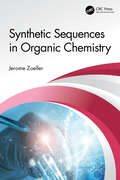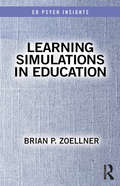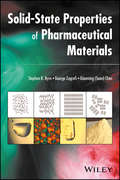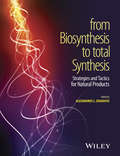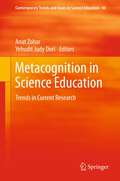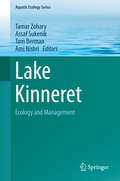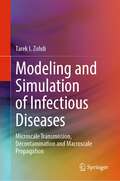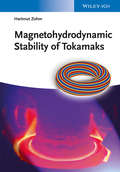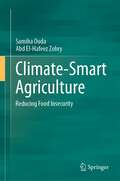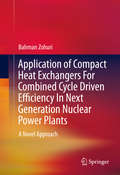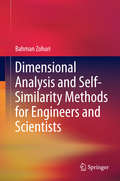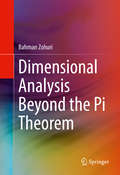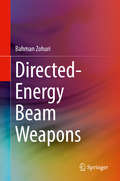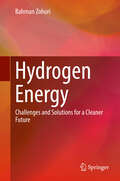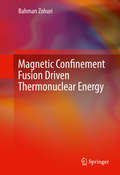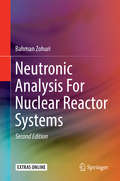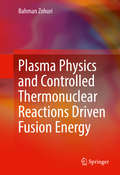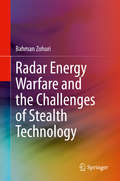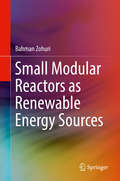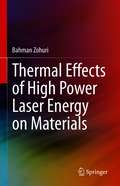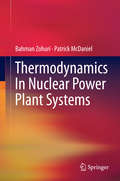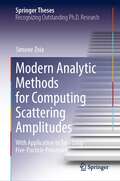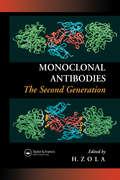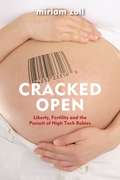- Table View
- List View
Synthetic Sequences in Organic Chemistry
by Jerome ZoellerDrawing on the vast amount of experience the author has gained from working in industrial and university laboratories, this collection of excerpt reports contains essential details from literature relevant to the synthesis of compounds on a milligram to kilogram scale. The excerpts are composed using ChemDraw software and compiled in a Word document. A number of the compounds that have eluded efficient preparation in the past are now presented. Material which will improve any chemist's existing synthetic methodology can be found here. Each of the six chapters, with eighty excerpts, illustrates a novel application of syntheses selected from twenty-first-century literature. Features: This professional text describes many of the classical and contemporary methods of synthesis that have recently found great value in the preparation of needed target compounds in the required quantities. Each example is extracted from a specific literature publication, which the user then would examine for details. This user-friendly professional text provides enormous aid in designing synthetic sequences. Appeals to a broad audience in both academic and industrial laboratories, basically any chemist in need of designing a synthetic sequence or just selecting a single reaction. Author has a vast amount of experience gained from working in academic and industrial laboratories.
Learning Simulations in Education (Ed Psych Insights)
by Brian P. ZoellnerTechnology-enabled simulations are increasingly used for students in K-12 education and have the potential to improve teaching and learning across domains. Across five chapters, this book explores the psychological foundation of simulation use in instruction, guiding readers through individual differences among learners and contexts while addressing theory, pedagogy, cognitive processes, and more. This concise volume is designed for any education course that includes simulations in the curriculum and will be indispensable for student researchers and both pre- and in-service teachers alike.
Solid-State Properties of Pharmaceutical Materials
by George Zografi Stephen R. Byrn Xiaoming Sean ChenPresents a detailed discussion of important solid-state properties, methods, and applications of solid-state analysis Illustrates the various phases or forms that solids can assume and discussesvarious issues related to the relative stability of solid forms and tendencies to undergo transformation Covers key methods of solid state analysis including X-ray powder diffraction, thermal analysis, microscopy, spectroscopy, and solid state NMR Reviews critical physical attributes of pharmaceutical materials, mainly related to drug substances, including particle size/surface area, hygroscopicity, mechanical properties, solubility, and physical and chemical stability Showcases the application of solid state material science in rational selection of drug solid forms, analysis of various solid forms within drug substance and the drug product, and pharmaceutical product development Introduces appropriate manufacturing and control procedures using Quality by Design, and other strategies that lead to safe and effective products with a minimum of resources and time
From Biosynthesis to Total Synthesis: Strategies and Tactics for Natural Products
by Alexandros L. ZografosFocusing on biosynthesis, this book provides readers with approaches and methodologies for modern organic synthesis. By discussing major biosynthetic pathways and their chemical reactions, transformations, and natural products applications; it links biosynthetic mechanisms and more efficient total synthesis. * Describes four major biosynthetic pathways (acetate, mevalonate, shikimic acid, and mixed pathways and alkaloids) and their related mechanisms* Covers reactions, tactics, and strategies for chemical transformations, linking biosynthetic processes and total synthesis* Includes strategies for optimal synthetic plans and introduces a modern molecular approach to natural product synthesis and applications* Acts as a key reference for industry and academic readers looking to advance knowledge in classical total synthesis, organic synthesis, and future directions in the field
Metacognition in Science Education
by Anat Zohar Yehudit Judy DoriWhy is metacognition gaining recognition, both in education generally and in science learning in particular? What does metacognition contribute to the theory and practice of science learning? Metacognition in Science Education discusses emerging topics at the intersection of metacognition with the teaching and learning of science concepts, and with higher order thinking more generally. The book provides readers with a background on metacognition and analyses the latest developments in the field. It also gives an account of best-practice methodology. Expanding on the theoretical underpinnings of metacognition, and written by world leaders in metacognitive research, the chapters present cutting-edge studies on how various forms of metacognitive instruction enhance understanding and thinking in science classrooms. The editors strive for conceptual coherency in the various definitions of metacognition that appear in the book, and show that the study of metacognition is not an end in itself. Rather, it is integral to other important constructs, such as self-regulation, literacy, the teaching of thinking strategies, motivation, meta-strategies, conceptual understanding, reflection, and critical thinking. The book testifies to a growing recognition of the potential value of metacognition to science learning. It will motivate science educators in different educational contexts to incorporate this topic into their ongoing research and practice.
Lake Kinneret
by Tamar Zohary Assaf Sukenik Tom Berman Ami NishriThis condensed volume summarizes updated knowledge on the warm-monomictic subtropical Lake Kinneret, including its geophysical setting, the dynamics of physical, chemical and biological processes and the major natural and anthropogenic factors that affect this unique aquatic ecosystem. This work expands on a previous monograph on Lake Kinneret published in 1978 and capitalizes on the outcome of more than 40 years of research and monitoring activities. These were intensively integrated with lake management aimed at sustainable use for supply of drinking water, tourism, recreation and fishery. The book chapters are aimed at the limnological community, aquatic ecologists, managers of aquatic ecosystems and other professionals. It presents the geographic and geological setting, the meteorology and hydrology of the region, continues with various aspects of the pelagic and the littoral systems. Finally, the last section of the book addresses lake management, demonstrating how the accumulated knowledge was applied in order to manage this important source of freshwater. The section on the pelagic system comprises the heart of the book, addressing the major physical processes, external and internal loading, the pelagic communities (from bacteria to fish), physiological processes and the major biogeochemical cycles in the lake.
Modeling and Simulation of Infectious Diseases: Microscale Transmission, Decontamination and Macroscale Propagation
by Tarek I. ZohdiThe COVID-19 pandemic that started in 2019-2020 has led to a gigantic increase in modeling and simulation of infectious diseases. There are numerous topics associated with this epoch-changing event, such as (a) disease propagation, (b) transmission, (c) decontamination, and (d) vaccines. This is an evolving field. The targeted objective of this book is to expose researchers to key topics in this area, in a very concise manner. The topics selected for discussion have evolved with the progression of the pandemic. Beyond the introductory chapter on basic mathematics, optimization, and machine learning, the book covers four themes in modeling and simulation infectious diseases, specifically: Part 1: Macroscale disease propagation, Part 2: Microscale disease transmission and ventilation system design, Part 3: Ultraviolet viral decontamination, and Part 4: Vaccine design and immune response. It is important to emphasize that the rapid speed at which the simulations operate makes the presented computational tools easily deployable as digital twins, i.e., digital replicas of complex systems that can be inexpensively and safely optimized in a virtual setting and then used in the physical world afterward, thus reducing the costs of experiments and also accelerating development of new technologies.
Magnetohydrodynamic Stability of Tokamaks
by Hartmut ZohmThis book bridges the gap between general plasma physics lectures and the real world problems in MHD stability. In order to support the understanding of concepts and their implication, it refers to real world problems such as toroidal mode coupling or nonlinear evolution in a conceptual and phenomenological approach. Detailed mathematical treatment will involve classical linear stability analysis and an outline of more recent concepts such as the ballooning formalism. The book is based on lectures that the author has given to Master and PhD students in Fusion Plasma Physics. Due its strong link to experimental results in MHD instabilities, the book is also of use to senior researchers in the field, i.e. experimental physicists and engineers in fusion reactor science.The volume is organized in three parts. It starts with an introduction to the MHD equations, a section on toroidal equilibrium (tokamak and stellarator), and on linear stability analysis. Starting from there, the ideal MHD stability of the tokamak configuration will be treated in the second part which is subdivided into current driven and pressure driven MHD. This includes many examples with reference to experimental results for important MHD instabilities such as kinks and their transformation to RWMs, infernal modes, peeling modes, ballooning modes and their relation to ELMs. Finally the coverage is completed by a chapter on resistive stability explaining reconnection and island formation. Again, examples from recent tokamak MHD such as sawteeth, CTMs, NTMs and their relation to disruptions are extensively discussed.
Climate-Smart Agriculture: Reducing Food Insecurity
by Abd El-Hafeez Zohry Samiha OudaThis book tackles the main feature of water-smart, soil-smart and crop-smart practices and their integration to sustainably enhance food production. The book includes some insights on the implications of using climate-smart practices in irrigated and rain-fed agriculture, and suggests approaches to eradicate the negative effects of water scarcity, climate variability and climate change. The book reviews the most important crops resilient to climate variability and their resistance to other biotic and abiotic stresses, and contains the existing practices in Egypt that achieved the three pillars of climate-smart agriculture
Application of Compact Heat Exchangers For Combined Cycle Driven Efficiency In Next Generation Nuclear Power Plants: A Novel Approach
by Bahman ZohuriCovers the fundamentals of combined-cycle plants to provide background for understanding the progressive design approaches at the heart of the text Discusses the types of compact heat exchanger surfaces, suggesting novel designs that can be considered for optimal cost effectiveness and maximum energy production Undertakes the thermal analysis of these compact heat exchangers throughout the life cycle, from the design perspective through operational and safety assurance stages This book describes the quest to create novel designs for compact heat exchangers in support of emergent combined cycle nuclear plants. The text opens with a concise explanation of the fundamentals of combined cycles, describing their efficiency impacts on electrical power generation systems. It then covers the implementation of these principles in nuclear reactor power systems, focusing on the role of compact heat exchangers in the combined cycle loop and applying them to the challenges facing actual nuclear power systems. The various types of compact heat exchanger surfaces and designs are given thorough consideration before the author turns his attention to discussing current and projected reactor systems, and how the novel design of these compact heat e xchangers can be applied to innovative designs, operation and safety analyses to optimize thermal efficiency. The book is written at an undergraduate level, but will be useful to practicing engineers and scientists as well.
Dimensional Analysis and Self-Similarity Methods for Engineers and Scientists
by Bahman ZohuriThis ground-breaking reference provides an overview of key concepts in dimensional analysis, and then pushes well beyond traditional applications in fluid mechanics to demonstrate how powerful this tool can be in solving complex problems across many diverse fields. Of particular interest is the book's coverage of dimensional analysis and self-similarity methods in nuclear and energy engineering. Numerous practical examples of dimensional problems are presented throughout, allowing readers to link the book's theoretical explanations and step-by-step mathematical solutions to practical implementations.
Dimensional Analysis Beyond the Pi Theorem
by Bahman ZohuriDimensional Analysis and Physical Similarity are well understood subjects, and the general concepts of dynamical similarity are explained in this book. Our exposition is essentially different from those available in the literature, although it follows the general ideas known as Pi Theorem. There are many excellent books that one can refer to; however, dimensional analysis goes beyond Pi theorem, which is also known as Buckingham's Pi Theorem. Many techniques via self-similar solutions can bound solutions to problems that seem intractable. A time-developing phenomenon is called self-similar if the spatial distributions of its properties at different points in time can be obtained from one another by a similarity transformation, and identifying one of the independent variables as time. However, this is where Dimensional Analysis goes beyond Pi Theorem into self-similarity, which has represented progress for researchers. In recent years there has been a surge of interest in self-similar solutions of the First and Second kind. Such solutions are not newly discovered; they have been identified and named by Zel'dovich, a famous Russian Mathematician in 1956. They have been used in the context of a variety of problems, such as shock waves in gas dynamics, and filtration through elasto-plastic materials. Self-Similarity has simplified computations and the representation of the properties of phenomena under investigation. It handles experimental data, reduces what would be a random cloud of empirical points to lie on a single curve or surface, and constructs procedures that are self-similar. Variables can be specifically chosen for the calculations.
Directed-Energy Beam Weapons
by Bahman ZohuriThis book introduces modern directed-energy beam weaponry and emerging technical concepts based on unclassified and declassified information. The book covers laser systems, analyzing the interaction between high-power laser beams and matter, and examines penetration of high power beams such as microwave and scalar wave. It also covers the use of particle and high-power radar beams and scalar wave as weapons of the future. In-depth coverage of the relevant mathematical and engineering topics and concepts are included. The book will provide scientists and engineers with valuable guidance on the fundamentals needed to understand state-of-the-art directed energy weaponry technology research and applications.Provides guidance on the fundamentals of state-of-the-art directed-energy weaponry technology;Introduces the physics behind directed-energy weapons;Offers in-depth coverage of mathematical and engineering topics.
Hydrogen Energy: Challenges and Solutions for a Cleaner Future
by Bahman ZohuriThis book describes the challenges and solutions the energy sector faces by shifting towards a hydrogen based fuel economy. The most current and up-to-date efforts of countries and leaders in the automotive sector are reviewed as they strive to develop technology and find solutions to production, storage, and distribution challenges. Hydrogen fuel is a zero-emission fuel when burned with oxygen and is often used with electrochemical cells, or combustion in internal engines, to power vehicles and electric devices. This book offers unique solutions to integrating renewable sources of energy like wind or solar power into the production of hydrogen fuel, making it a cost effective, efficient and truly renewable alternative fuel.
Magnetic Confinement Fusion Driven Thermonuclear Energy
by Bahman ZohuriThis book covers the principles and practices behind the Magnetic Confinement Fusion (MCF) approach to driven new source of energy. All possible technical methods, including well established theoretical research, as well as findings tested in an experimental tokamak reactor, are examined in order to determine how to best achieve breakeven via this pathway to plasma-driven fusion. The author undertakes a life cycle analysis to compare and contrast the efficiency, environmental impacts, and operating costs of plasma-driven MCF fusion against other forms of energy generation currently in widespread use. The associated computer code and numerical analysis are included in the book. No prior knowledge of MCF and no more than basic background in plasma physics is required.
Neutronic Analysis For Nuclear Reactor Systems
by Bahman ZohuriThis expanded new edition develops the theory of nuclear reactors from the fundamentals of fission to the operating characteristics of modern reactors. The first half of the book emphasizes reactor criticality analysis and all of the fundamentals that go into modern calculations. Simplified one group diffusion theory models are presented and extended into sophisticated multi-group transport theory models. The second half of the book deals with the two main topics of interest related to operating reactors – reactor kinetics/dynamics, and in-core fuel management. Additional chapters have been added to expand and bring the material up-to-date and include the utilization of more computer codes. Code models and detailed data sets are provided along with example problems making this a useful text for students and researchers wishing to develop an understanding of nuclear power and its implementation in today’s modern energy spectrum.Covers the fundamentals of neutronic analysis for nuclear reactor systems to help understand nuclear reactor theory;Describes the benefits, uses, safety features, and challenges related to implementation of Small Modular Reactors;Provides examples, data sets, and code to assist the reader in obtaining mastery over the subjects.
Plasma Physics and Controlled Thermonuclear Reactions Driven Fusion Energy
by Bahman ZohuriThis book covers the basic principles of both fusion and plasma physics, examining their combined application for driving controlled thermonuclear energy. The author begins by explaining the underlying scientific theory, and then goes on to explore the nuances of deployment within thermonuclear reactors. The potential for these technologies to help shape the new generation of clean energy is examined in-depth, encompassing perspectives both highlighting benefits, and warning of challenges associated with the nuclear fusion pathway. The associated computer code and numerical analysis are included in the book. No prior knowledge of plasma physics or fusion is required.
Radar Energy Warfare and the Challenges of Stealth Technology
by Bahman ZohuriThis book provides a solid foundation for understanding radar energy warfare and stealth technology. The book covers the fundamentals of radar before moving on to more advanced topics, including electronic counter and electronic counter-counter measures, radar absorbing materials, radar cross section, and the science of stealth technology. A final section provides an introduction to Luneberg lens reflectors. The book will provide scientists, engineers, and students with valuable guidance on the fundamentals needed to understand state-of-the-art radar energy warfare and stealth technology research and applications.
Small Modular Reactors as Renewable Energy Sources
by Bahman ZohuriThis book highlights Small Modular Reactors (SMRs) as a viable alternative to the Nuclear Power Plants (NPPs), which have been used as desalination plant energy sources. SMRs have lower investment costs, inherent safety features, and increased availability compared to NPPs. The unique and innovative approach to implementation of SMRs as part of Gen-IV technology outlined in this book contributes to the application of nuclear power as a supplementary source to renewable energy. Discusses Gen-IV Power plants, their efficiency, cost effectiveness, safety, and methods to supply renewable energy;Presents Small Modular Reactors as a viable alternative to Nuclear Power Plants;Describes the benefits, uses, safety features, and challenges related to implementation of Small Modular Reactors.
Thermal Effects of High Power Laser Energy on Materials
by Bahman ZohuriThis book offers a tutorial on the response of materials to lasers, with an emphasis on simple, intuitive models with analytical and mathematical solutions, using techniques such as Laplace Transformation to solve most complex heat conduction equations. It examines the relationship between existing thermal parameters of simple metals and looks at the characteristics of materials and their properties in order to investigate and perform theoretical analysis from a heat conduction perspective mathematically. Topics discussed include optical reflectivity of metals at infrared (IR) wavelengths, laser-induced heat flow in materials, the effects of melting and vaporization, the impulse generated in materials by pulsed radiation, and the influence of the absorption in the blow-off region in irradiated material. Written for engineers, scientists, and graduate-level engineering and physics students, Thermal Effects of High Power Laser Energy on Materials provides an in-depth look at high energy laser technology and its potential industrial and commercial applications in such areas as precision cutting, LIDAR and LADAR, and communications. The knowledge gained from this allows you to apply spaced-based relay mirror in order to compensate laser beam divergence back to its original coherency by preventing further thermal blooming that takes place during laser beam propagation through the atmosphere.Examines the state-of-the-art in currently available high energy laser technologies;Includes computer codes that deal with the response of materials to laser radiation;Provides detailed mathematical solutions of thermal response to laser radiation.
Thermodynamics In Nuclear Power Plant Systems
by Bahman Zohuri Patrick McdanielThis book covers the fundamentals of thermodynamics required to understand electrical power generation systems, honing in on the application of these principles to nuclear reactor power systems. It includes all the necessary information regarding the fundamental laws to gain a complete understanding and apply them specifically to the challenges of operating nuclear plants. Beginning with definitions of thermodynamic variables such as temperature, pressure and specific volume, the book then explains the laws in detail, focusing on pivotal concepts such as enthalpy and entropy, irreversibility, availability, and Maxwell relations. Specific applications of the fundamentals to Brayton and Rankine cycles for power generation are considered in-depth, in support of the book's core goal- providing an examination of how the thermodynamic principles are applied to the design, operation and safety analysis of current and projected reactor systems. Detailed appendices cover metric and English system units and conversions, detailed steam and gas tables, heat transfer properties, and nuclear reactor system descriptions.
Modern Analytic Methods for Computing Scattering Amplitudes: With Application to Two-Loop Five-Particle Processes (Springer Theses)
by Simone ZoiaThis work presents some essential techniques that constitute the modern strategy for computing scattering amplitudes. It begins with an introductory chapter to fill the gap between a standard QFT course and the latest developments in the field. The author then tackles the main bottleneck: the computation of the loop Feynman integrals. The most efficient technique for their computation is the method of the differential equations. This is discussed in detail, with a particular focus on the mathematical aspects involved in the derivation of the differential equations and their solution. Ample space is devoted to the special functions arising from the differential equations, to their analytic properties, and to the mathematical techniques which allow us to handle them systematically. The thesis also addresses the application of these techniques to a cutting-edge problem of importance for the physics programme of the Large Hadron Collider: five-particle amplitudes at two-loop order. It presents the first analytic results for complete two-loop five-particle amplitudes, in supersymmetric theories and QCD. The techniques discussed here open the door to precision phenomenology for processes of phenomenological interest, such as three-photon, three-jet, and di-photon + jet production.
Systems Thinking: From Heresy to Practice
by Keivan Zokaei John Seddon Brendan O'DonovanSystems Thinking is a topic which is at the forefront of how we think about management in the Public Sector and Service Industries. This collection from leading thinkers in the field takes a case study approach to a variety of issueswhich encompass topics such as Banking, Electrical Distribution, Manufacturing andAdult Social Care. "
Monoclonal Antibodies: The Second Generation
by Heddy ZolaA review of what needs to be done to realise the potential of monoclonal antibodies. The book assesses the competing technologies with advice on the best approach for a particular situation.
Cracked Open: Liberty, Fertility and the Pursuit of High Tech Babies
by Miriam Zoll Judy Norsigian Michele GoodwinCracked Open is Miriam Zoll's eye-opening account of growing into womanhood with the simultaneous opportunities offered by the U. S. women's movement and new discoveries in reproductive technologies. Influenced by the pervasive media and cultural messages suggesting that science had finally eclipsed Mother Nature, Zoll postponed motherhood until the age of 40. When things didn't progress as she had hoped, she enters a world of medical seduction and bioethical quagmires. Desperate to conceive, she surrenders to unproven treatments and procedures only to learn that the odds of becoming a mother through reproductive technologies are far less than she and her generation had been led to believe.
